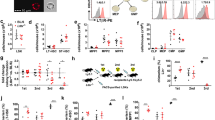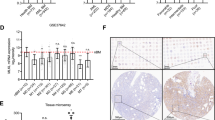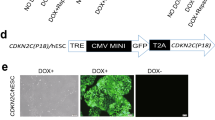Abstract
LT-related inducible ligand that competes for glycoprotein D binding to herpesvirus entry mediator on T cells (LIGHT) is a recently cloned type II transmembrane protein belonging to the TNF family that was originally identified as a weak inducer of apoptosis. This cytokine has been extensively defined in its role on T-cell regulation and dendritic cell maturation. However, whether this cytokine regulates stem cell proliferation and/or differentiation remains unknown. In this study, we transduced exogenous LIGHT into embryonic stem cells (ES cells) and found it induced their differentiation. The expression of phospho-STAT3, Nanog and Oct-4 was reduced in LIGHT-transduced ES cells compared with wild-type ES cells. LIGHT-transduced ES cells exhibit a low level of SSEA-1 surface antigen and alkaline phosphatase staining compared with wild-type cells. Introduction of LIGHT into ES cells results in the dephosphorylation of MKP-3 and activation of extracellular signal-regulated kinase (ERK)5. When ERK5 was inhibited by the specific inhibitor PD184352 or knocked down by ERK5 siRNA, reduction of Oct-4 and SSEA-1 expression was rescued. We conclude that LIGHT overrides Leukemia inhibitory factor to induce ES cell differentiation associated with activation of ERK5.
This is a preview of subscription content, access via your institution
Access options
Subscribe to this journal
Receive 50 print issues and online access
$259.00 per year
only $5.18 per issue
Buy this article
- Purchase on Springer Link
- Instant access to full article PDF
Prices may be subject to local taxes which are calculated during checkout







Similar content being viewed by others
Abbreviations
- EB:
-
embryoid body
- ERK:
-
extracellular signal-regulated kinase
- ES cells:
-
Embryonic stem cells
- HVEM:
-
herpesvirus entry mediator
- LIF:
-
leukemia inhibitory factor
- LT-β:
-
lymphoid toxin-β
- LIGHT:
-
LT-related inducible ligand that competes for glycoprotein D binding to herpesvirus entry mediator on T cells
- MKP-3:
-
MAP kinase phosphatase-3
- siRNA:
-
small interfering RNA
- sLIGHT:
-
soluble LIGHT
- SSEA-1:
-
stage-specific embryonic antigen-1
References
Bode JG, Schweigart J, Kehrmann J, Ehlting C, Schaper F, Heinrich PC and Haussinger D . (2003). J. Immunol., 171, 257–266.
Boeuf H, Merienne K, Jacquot S, Duval D, Zeniou M, Hauss C, Reinhardt B, Huss-Garcia Y, Dierich A, Frank DA, Hanauer A and Kedinger C . (2001). J. Biol. Chem., 276, 46204–46211.
Chambers I, Colby D, Robertson M, Nichols J, Lee S, Tweedie S and Smith A . (2003). Cell, 113, 643–655.
Chen Y, Ke Q, Yang Y, Rana JS, Tang J, Morgan JP and Xiao YF . (2003). FASEB J., 17, 2231–2239.
Evans MJ and Kaufman MH . (1981). Nature, 292, 154–156.
Fandrich F, Lin X, Chai GX, Schulze M, Ganten D, Bader M, Holle J, Huang DS, Parwaresch R, Zavazava N and Binas B . (2002). Nat. Med., 8, 171–178.
Harrop JA, McDonnell PC, Brigham-Burke M, Lyn SD, Minton J, Tan KB, Dede K, Spampanato J, Silverman C, Hensley P, DiPrinzio R, Emery JG, Deen K, Eichman C, Chabot-Fletcher M, Truneh A and Young PR . (1998). J. Biol. Chem., 273, 27548–27556.
Hayashi M, Kim SW, Imanaka-Yoshida K, Yoshida T, Abel ED, Eliceiri B, Yang Y, Ulevitch RJ and Lee JD . (2004). J. Clin. Invest., 113, 1138–1148.
Kamakura S, Moriguchi T and Nishida E . (1999). J. Biol. Chem., 274, 26563–26571.
Kato Y, Tapping RI, Huang S, Watson MH, Ulevitch RJ and Lee JD . (1998). Nature, 395, 713–716.
Lynch CN, Wang YC, Lund JK, Chen YW, Leal JA and Wiley SR . (1999). J. Biol. Chem., 274, 8455–8459.
Mauri DN, Ebner R, Montgomery RI, Kochel KD, Cheung TC, Yu GL, Ruben S, Murphy M, Eisenberg RJ, Cohen GH, Spear PG and Ware CF . (1998). Immunity, 8, 21–30.
Mody N, Campbell DG, Morrice N, Peggie M and Cohen P . (2003). Biochem. J., 372, 567–575.
Morel Y, Truneh A, Sweet RW, Olive D and Costello RT . (2001). J. Immunol., 167, 2479–2486.
Nakaoka Y, Nishida K, Fujio Y, Izumi M, Terai K, Oshima Y, Sugiyama S, Matsuda S, Koyasu S, Yamauchi-Takihara K, Hirano T, Kawase I and Hirota H . (2003). Circ. Res., 93, 221–229.
Niwa H, Burdon T, Chambers I and Smith A . (1998). Genes Dev., 12, 2048–2060.
Pan GJ, Chang ZY, Scholer HR and Pei D . (2002). Cell Res., 12, 321–329. Review.
Sato M and Nakano T . (2001). Intern. Med., 40, 195–200.
Smith AG . (2001). Annu. Rev. Cell. Dev. Biol., 17, 435–462.
Smith AG, Heath JK, Donaldson DD, Wong GG, Moreau J, Stahl M and Rogers D . (1988). Nature, 336, 688–690.
Sohn SJ, Sarvis BK, Cado D and Winoto A . (2002). J. Biol. Chem., 277, 43344–43351.
Tamada K, Shimozaki K, Chapoval AI, Zhu G, Sica G, Flies D, Boone T, Hsu H, Fu YX, Nagata S, Ni J and Chen L . (2000). Nat. Med., 6, 283–289.
Wang Y, Wang F, Sun T, Trostinskaia A, Wygle D, Puscheck E and Rappolee DA . (2004). Dev. Dyn., 231, 72–87.
Wiley SR, Cassiano L, Lofton T, Davis-Smith T, Winkles JA, Lindner V, Liu H, Daniel TO, Smith CA and Fanslow WC . (2001). Immunity, 15, 837–846.
Williams RL, Hilton DJ, Pease S, Willson TA, Stewart CL, Gearing DP, Wagner EF, Metcalf D, Nicola NA and Gough NM . (1988). Nature, 336, 684–687.
Wu da Y and Yao Z . (2005). Cell Res., 15, 317–324.
Wuu YD, Pampfer S, Vanderheyden I, Lee KH and De Hertogh R . (1998). Biol. Reprod., 58, 1416–1424.
Zou GM and Hu WY . (2005). J. Cell. Physiol., 205, 437–443.
Zou GM, Martinson J, Hu WY, Tam and Klingemann HG . (2004). Cancer Immunol. Immunother., 53, 681–689.
Zou GM, Reznikoff-Etievant MF, Leon A, Verge V, Hirsch F and Milliez J . (2000). Am. J. Reprod. Immunol., 43, 240–248.
Zou GM, Wu W, Chen J and Rowley JD . (2003a). Biol. Cell., 95, 365–371.
Zou GM and Zavazava N . (2003b). Transplant. Proc., 35, 2827–2829.
Acknowledgements
We thank Martina Berg (University of Iowa) for part of technical assistance and Dr Baoli Yang (University of Iowa) for helpful discussion. Part of this study was performed on Dr Yan Chen's lab in Indiana University (Indianapolis).
Author information
Authors and Affiliations
Corresponding author
Rights and permissions
About this article
Cite this article
Zou, GM., Chen, JJ. & Ni, J. LIGHT induces differentiation of mouse embryonic stem cells associated with activation of ERK5. Oncogene 25, 463–469 (2006). https://doi.org/10.1038/sj.onc.1208987
Received:
Revised:
Accepted:
Published:
Issue Date:
DOI: https://doi.org/10.1038/sj.onc.1208987
Keywords
This article is cited by
-
RNAi in embryonic stem cells
Stem Cell Reviews (2006)



